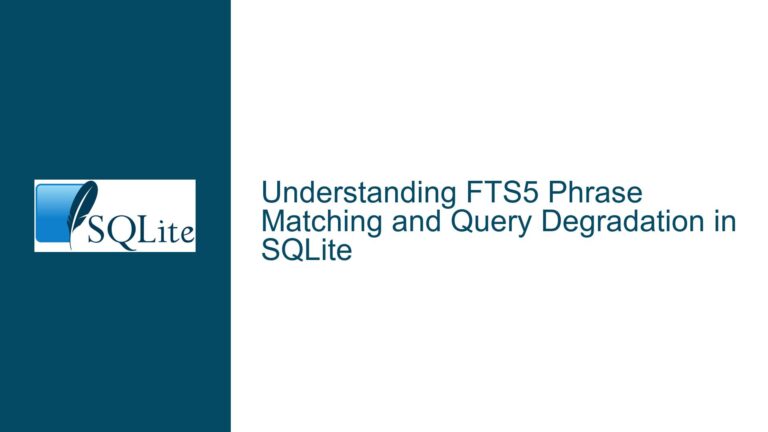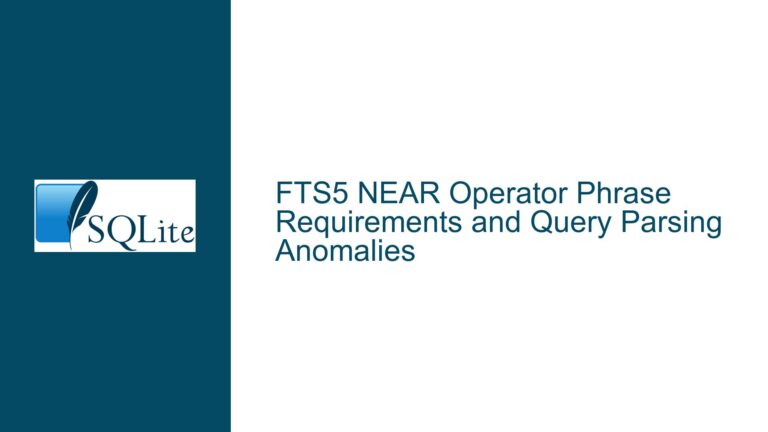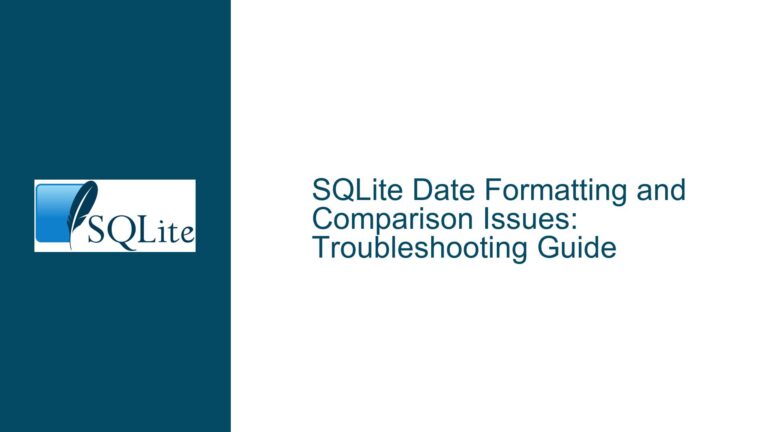SQLite Boolean Query Issue: EXISTS Clause and PHP Integration
SQLite Boolean Query Issue with EXISTS Clause
The core issue revolves around attempting to retrieve a boolean result from an SQLite database using the EXISTS clause within a PHP environment. The user is trying to determine whether a specific record exists in a table (myTable) based on a condition (company='SmartCo'). The expected outcome is a boolean value (TRUE or FALSE) that can be used in PHP to trigger specific actions, such as displaying a message indicating whether the record exists or not.
However, the user encounters several problems:
- The SQLite query does not return a boolean value directly.
- The PHP code does not correctly interpret the result of the SQLite query.
- There is confusion about how to handle the result set returned by the SQLite query in PHP.
SQLite does not have a native boolean data type. Instead, it uses integers 0 and 1 to represent FALSE and TRUE, respectively. This discrepancy between SQLite’s data types and PHP’s expectations is a significant source of confusion. Additionally, the user’s initial query syntax is incorrect, leading to errors such as "incomplete input."
Interrupted Write Operations Leading to Index Corruption
The primary cause of the issue lies in the misunderstanding of how SQLite handles boolean-like queries and how PHP interacts with SQLite’s result sets. Here are the key factors contributing to the problem:
SQLite’s Lack of Native Boolean Type: SQLite does not have a dedicated boolean data type. Instead, it uses integers
0and1to represent boolean values. This means that any query expecting a boolean result will return an integer, which must be interpreted correctly in the application layer (in this case, PHP).Incorrect Query Syntax: The user’s initial query is syntactically incorrect. The
EXISTSclause is not properly closed, and the string valueSmartCois not enclosed in quotes. This leads to SQLite returning an "incomplete input" error.Misinterpretation of Query Results in PHP: The user attempts to directly assign the result of the SQLite query to a PHP variable expecting a boolean value. However, the
querymethod in PHP’s SQLite3 extension returns a result object, not a direct boolean value. This result object must be processed to extract the actual data.Improper Use of PHP’s SQLite3 Extension: The user is not familiar with the correct methods to fetch data from the result object returned by the
querymethod. This leads to confusion about how to interpret the0or1returned by theEXISTSclause.Lack of Error Handling: The user’s code does not include proper error handling to diagnose issues such as syntax errors or failed queries. This makes it difficult to identify the root cause of the problem.
Implementing PRAGMA journal_mode and Database Backup
To resolve the issue, follow these detailed troubleshooting steps and solutions:
Step 1: Correct the SQL Query Syntax
The first step is to ensure that the SQL query is syntactically correct. The EXISTS clause must be properly closed, and string values must be enclosed in quotes. Here is the corrected query:
SELECT EXISTS (SELECT 1 FROM myTable WHERE company='SmartCo');
This query will return 1 if a record with company='SmartCo' exists in myTable, and 0 otherwise.
Step 2: Use the Correct PHP Method to Execute the Query
Instead of using the query method, which returns a result object, use the querySingle method. This method is designed to return a single value from the query, which is ideal for this use case. Here is how to use it:
$EntryExistsBoolean = $db->querySingle("SELECT EXISTS (SELECT 1 FROM myTable WHERE company='SmartCo')");
Step 3: Interpret the Result Correctly in PHP
Since SQLite returns 0 or 1, you need to interpret these values as boolean in PHP. Here is how to do it:
if ($EntryExistsBoolean === 0) {
echo "Record does not exist";
} else {
echo "Record exists";
}
Alternatively, you can use a simpler condition:
if (!$EntryExistsBoolean) {
echo "Record does not exist";
} else {
echo "Record exists";
}
Step 4: Add Error Handling
To ensure that any issues with the query are caught and diagnosed, add error handling to your PHP code. This will help you identify problems such as syntax errors or connection issues:
try {
$EntryExistsBoolean = $db->querySingle("SELECT EXISTS (SELECT 1 FROM myTable WHERE company='SmartCo')");
if ($EntryExistsBoolean === 0) {
echo "Record does not exist";
} else {
echo "Record exists";
}
} catch (Exception $e) {
echo "Error: " . $e->getMessage();
}
Step 5: Verify the Database Connection and Table Structure
Ensure that the database connection is correctly established and that the table myTable exists with the correct structure. You can use the following SQL command to verify the table structure:
PRAGMA table_info(myTable);
This will return information about the columns in myTable, including their names and data types.
Step 6: Use Prepared Statements for Security
To prevent SQL injection and improve performance, use prepared statements. Here is how to modify the code to use prepared statements:
$stmt = $db->prepare("SELECT EXISTS (SELECT 1 FROM myTable WHERE company=:company)");
$stmt->bindValue(':company', 'SmartCo', SQLITE3_TEXT);
$EntryExistsBoolean = $stmt->execute()->fetchArray(SQLITE3_NUM)[0];
if ($EntryExistsBoolean === 0) {
echo "Record does not exist";
} else {
echo "Record exists";
}
Step 7: Debugging and Logging
If the issue persists, add debugging and logging to your code to capture more information about the query execution and result:
error_log("Executing query: SELECT EXISTS (SELECT 1 FROM myTable WHERE company='SmartCo')");
$EntryExistsBoolean = $db->querySingle("SELECT EXISTS (SELECT 1 FROM myTable WHERE company='SmartCo')");
error_log("Query result: " . $EntryExistsBoolean);
if ($EntryExistsBoolean === 0) {
echo "Record does not exist";
} else {
echo "Record exists";
}
Step 8: Consider Using COUNT for Simplicity
While EXISTS is more efficient for checking the existence of a record, using COUNT can be simpler to understand and implement. Here is how to use COUNT:
$count = $db->querySingle("SELECT COUNT(*) FROM myTable WHERE company='SmartCo'");
if ($count === 0) {
echo "Record does not exist";
} else {
echo "Record exists";
}
Step 9: Review PHP Documentation
Finally, review the PHP documentation for the SQLite3 extension to ensure that you are using the correct methods and understanding their behavior:
By following these steps, you should be able to resolve the issue and correctly retrieve a boolean-like result from an SQLite database using PHP. Remember that SQLite’s lack of a native boolean type requires careful handling of the integer results returned by queries, and proper error handling and debugging are essential for diagnosing and fixing issues.






